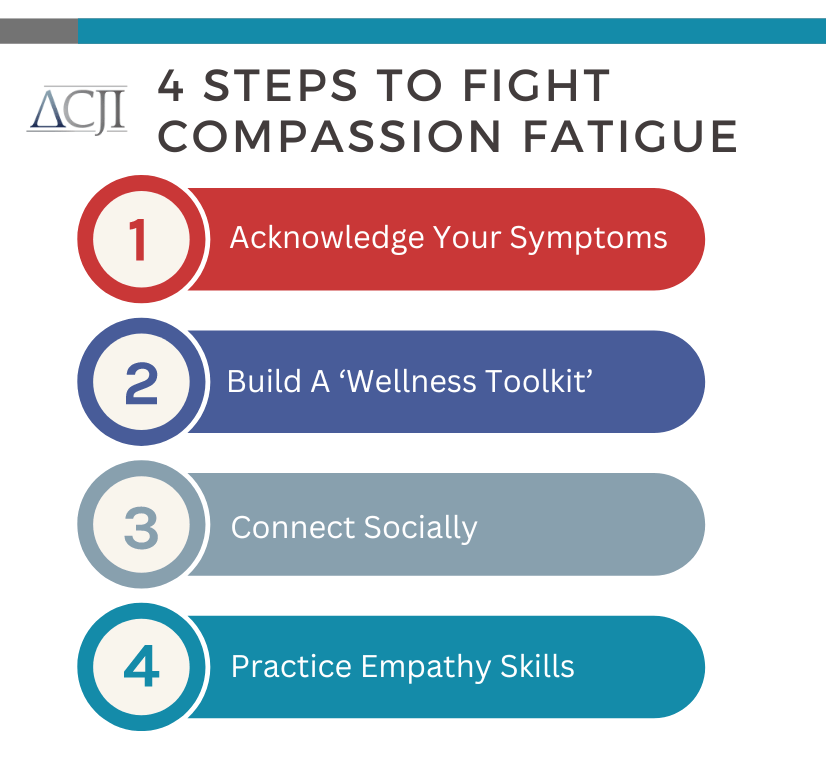Do You Have Compassion Fatigue?
January 22, 2024 – Compassion fatigue is real and anyone can suffer from it. You may feel it at home with your partner and your kids or roommate or aging parents. You might feel the symptoms as a nurse or social worker or teacher or attorney. Really, it can happen in any scenario where you set your own needs aside to attend to the needs of others.
Table of Contents
Causes And Symptoms Of Compassion Fatigue
For those of us working in community-led reentry and in justice agencies to help people, it requires a lot of energy and empathy. Problem is, each of us has a limited supply of both. When you run out of that supply, you feel the negative consequences.
How do you know if it’s happening to you?
- You feel overwhelmed and/or exhausted.
- You disengage in some of the things you are responsible for or otherwise enjoy.
- You feel drained and like you have little to give.
- You care less about other people’s problems. (i.e., You have less empathy than normal.)
- You have a decreased sense of accomplishment. (e.g., You might say things like, “Nothing works to fix the problem.”)
There are many assessments available online to help you further decide if you have compassion fatigue. But remember, there is no replacement for talking with your loved ones and peers who are most likely to notice changes in how you show up at home and in the workplace. You can also visit with your doctor and/or counselor to help determine the degree to which compassion fatigue is impacting your daily life.

Burnout vs Compassion Fatigue
Compassion fatigue has two elements: burnout and secondary traumatic stress. Burnout can be defined as physical and mental exhaustion that leads to a reduced ability to cope. It comes with feelings of frustration and helplessness.
Secondary traumatic stress can be defined as a type of stress that results from feelings of empathy experienced when working with others who are experiencing trauma.
At ACJI, we are often asked about the difference between burnout and compassion fatigue. As you read above, they are quite similar, but here are two important distinctions.
- Burnout occurs when you participate in a difficult job or activity for a length of time. Compassion fatigue can happen very quickly. Keep in mind that your background and personal experience can increase the impact of compassion fatigue and how you respond.
- Burnout could be a result of the people around you, but it doesn’t have to be. Compassion fatigue is a direct result of how you react to the people you are caring for.
Get access to short videos and microtechniques for working optimally in high-stress professions with ACJI’s Learn@Work Suite.
With three tracks, Lead@Work, Innovate@Work, and SelfCare@Work (which includes a video episode about compassion fatigue), there is content for all in the business of caring for others.
Self-Care Techniques To Address Compassion Fatigue
Caring for others can give you purpose. However, caring too much can have consequences. ACJI has identified four steps to help avoid compassion fatigue, or at least minimize it.
- Acknowledge your symptoms and understand the effects compassion fatigue is having on your life
- Build a Wellness Toolkit that contains a number of self-care techniques including breath and mindfulness activities. Identify several things that work for you and then pull out tools every day, throughout the day. (Check out this SelfCare@Work episode for more on building your toolkit.)
- Connect socially. Talk about what’s bothering you.
- Practice empathy skills.
More on #4 (empathy skills): Several studies have shown that those who regularly practice acts of kindness report more feelings of happiness. So, while it seems counterintuitive to do MORE caring to combat compassion fatigue, there’s proof it works.
The trick here is to do it in other contexts. Holding a door for someone at the grocery store or shoveling an elderly neighbor’s sidewalk doesn’t require you to experience secondary trauma, but both do allow you to make someone else’s day brighter…and yours too, consequently.
Last, many experts talk about finding the right amount of empathy. What boundaries can you put in place to keep yourself from becoming emotionally hijacked? Creating boundaries is a very important empathy skill. Try leaning into proven motivational interviewing techniques to protect yourself from getting too close to those experiencing trauma around you.

In Summary
We all have those people, places, and situations that drain our energy, some you can avoid and some you can’t. If you work in the justice system or another profession where you care for people, please take care of yourself, too.
When you recognize that you are having feelings of futility and just don’t want to do the work anymore, develop practices to combat the fatigue and lean on your support network to process your feelings. Last, build your empathy skills—this is critical.
By doing this work, you will combat burnout and, hopefully, be able to do your work for many years to come.
Frequently Asked Questions About Compassion Fatigue
What Are Some Compassion Fatigue Examples?
We have seen compassion fatigue show up in a lot of different ways. Your experience with compassion fatigue might look and sound a lot different than ours. The most important thing here is to notice shifts or changes in how you are showing up at work.
One of ACJI’s co-founders, Dr. Alexandra Walker, shares this experience as an example:
“When I was on the Parole Board I heard a lot of horrific and traumatic stories of loss, hurt, and devastation from all sides. Unfortunately, there were many patterns to what I would hear, and, over time, I found myself ‘checking out’ and making assumptions about people’s experiences. It became harder to be fully present and really listen to their unique experiences.
I learned that compassion fatigue can show up as irritability sometimes and that self-care strategies can lose their impact, which is one of the reasons why we here at ACJI feel so strongly about having a full toolbox of strategies so you can mix it up.”
What Are Compassion Fatigue Exercises?
There are a number of self-care exercises that address compassion fatigue ranging from breathwork to perspective-taking to exercise to vacation time. In our experience, the more tools you can pull from your wellness toolkit the better. See the section above titled “Self-Care Techniques To Address Compassion Fatigue” for more exercises.
What Are Other Words To Describe Compassion Fatigue?
There are many terms used to describe compassion fatigue including vicarious trauma, empathy fatigue, and caregiver burnout. There are also several other conditions that are similar in nature or have crossover. For example, someone with PTSD may exhibit similar symptoms. Really, it doesn’t matter what you call it as long as you acknowledge why you may be struggling and identify compassion fatigue exercises to help.
Does ACJI Have A Compassion Fatigue Video?
Yes, we do! It is part of SelfCare@Work video series. Learn more on our website here.





